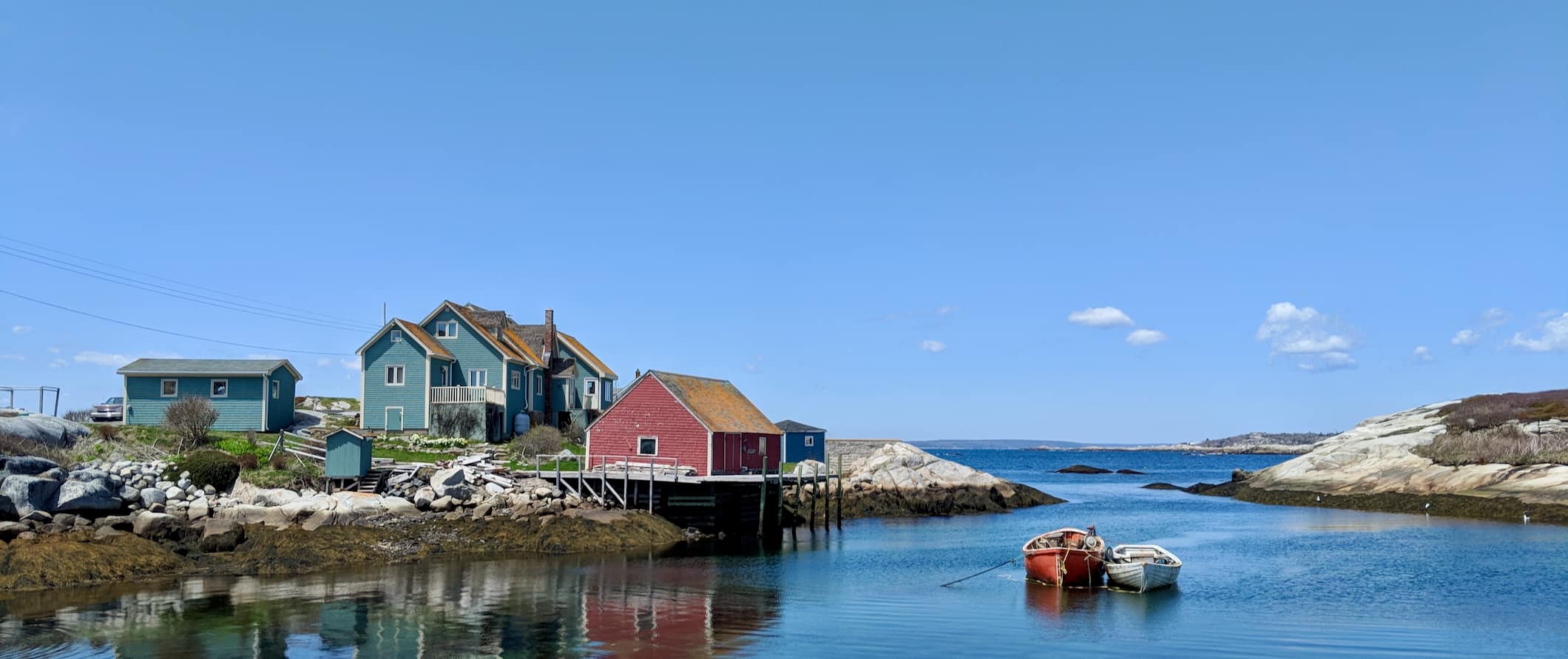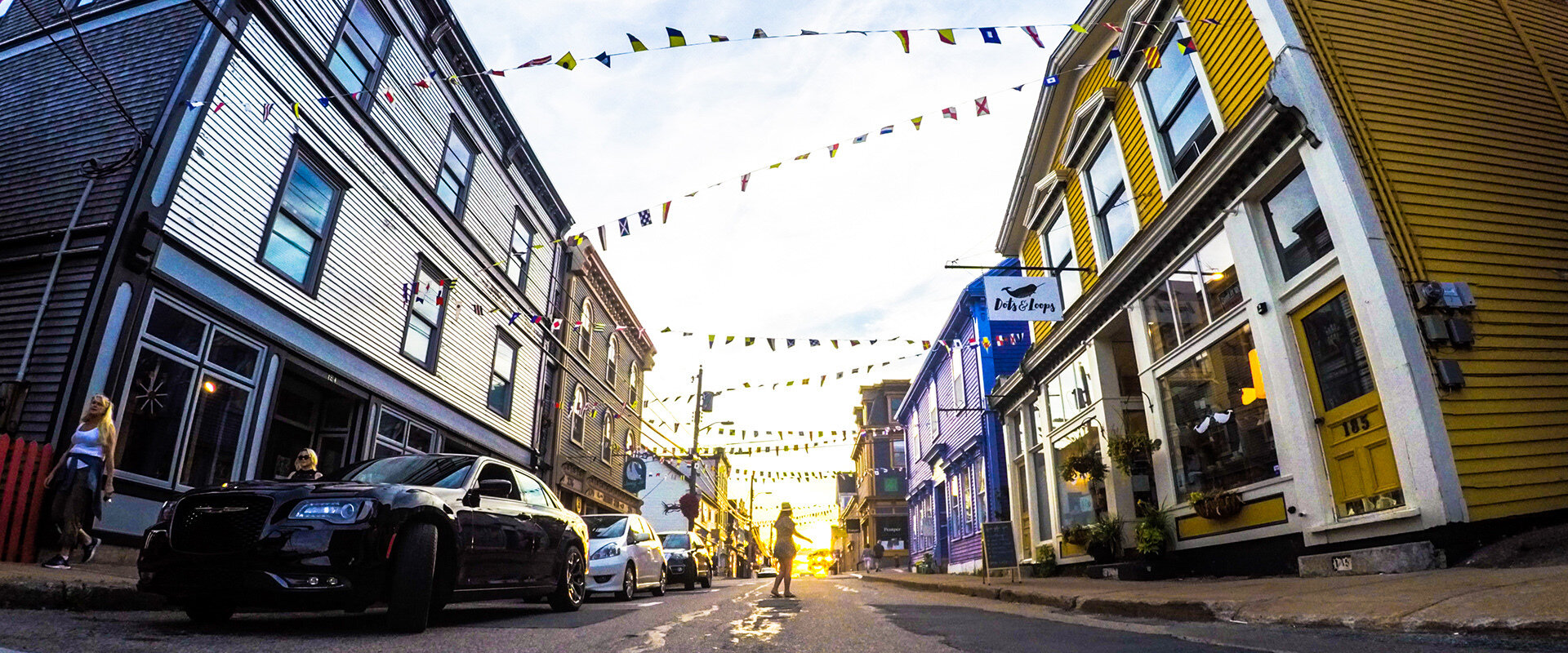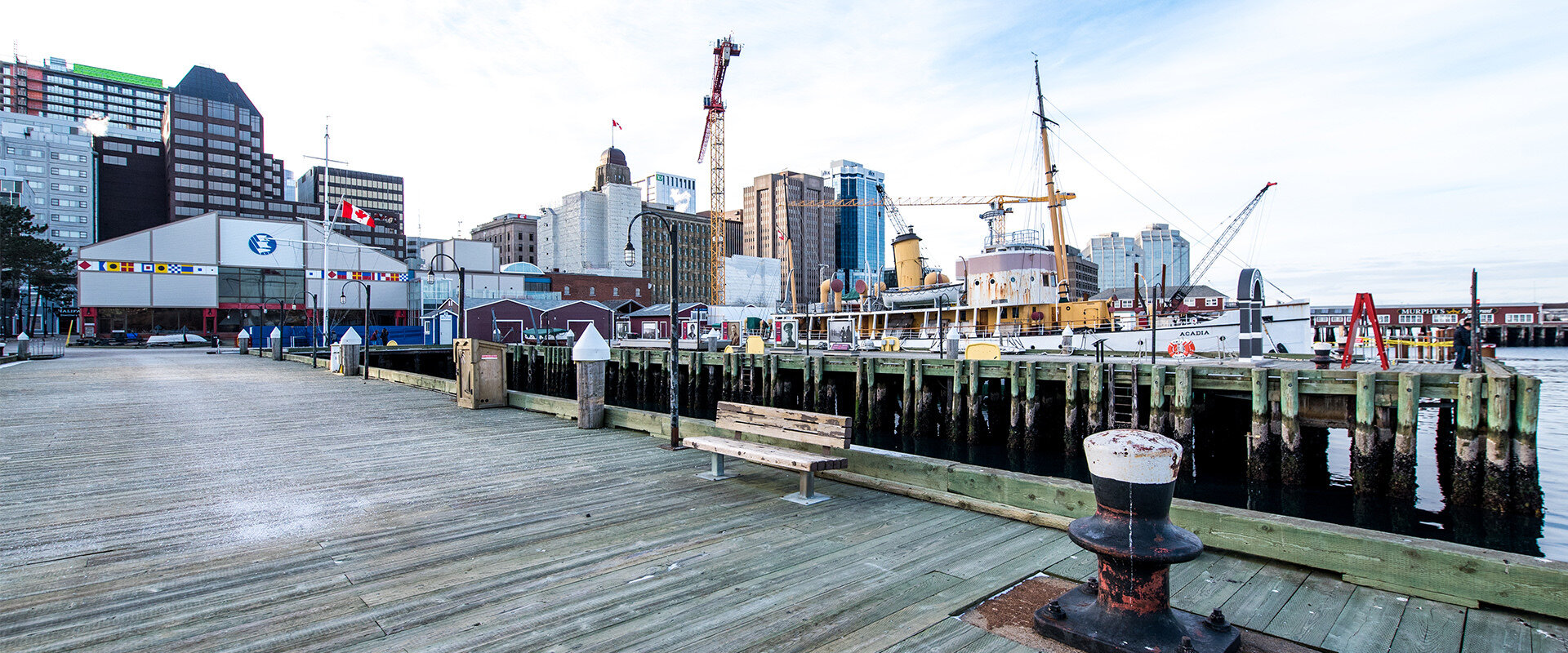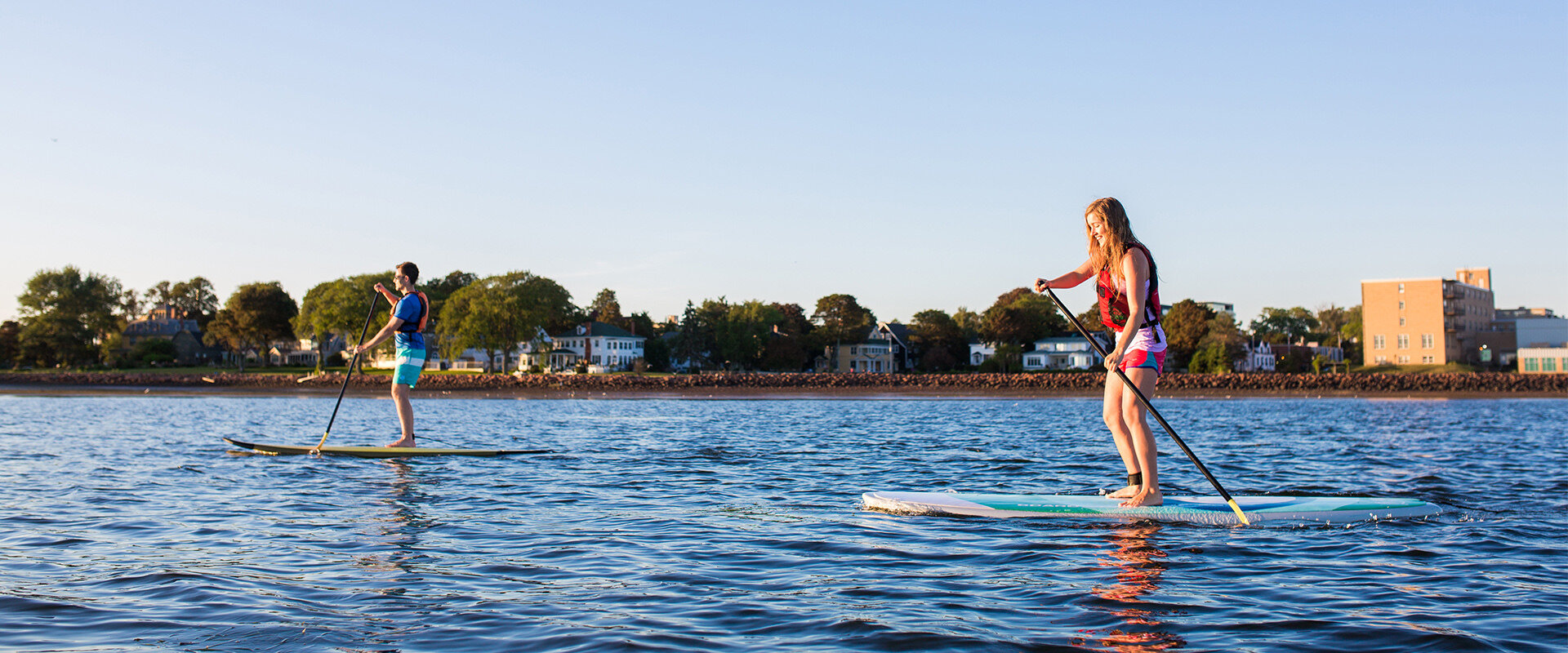

How to travel around Nova Scotia without a car: All the information you will need!
Liked this post? Save it for later!
If you are visiting Nova Scotia without a car, then this post will help you know what you can (and can’t) do, the best places to stay, and helpful resources for traveling around. Traveling around Nova Scotia without a car will be more difficult than renting a car because Nova Scotia isn’t as well-connected by public transportation compared to areas in other countries. But, if need help traveling around Nova Scotia without a car then this post is for you!

What to do in Nova Scotia without a car
If you are staying in Nova Scotia without a car, it is strongly recommended to base yourself in Halifax and do day trips from there. Halifax is the capital of Nova Scotia, and has an international airport. It is a walkable city, so it is easy to spend 1-2 days exploring Halifax on foot. There are a lot of other beautiful and popular towns within an hour from Halifax (Wolfville, Mahone Bay, Lunenburg, and the Bay of Fundy area).
If you are interested in visiting Cape Breton Nova Scotia without a car, then there are guided multi-day group tours available from Halifax too ! Getting to Cape Breton on your own is about 5 hours from Halifax via bus, and the flights to get there are expensive. Traveling around Cape Breton (specifically the Cabot Trail), will be next to impossible without a car, so a guided tour is your best option.
How to get to downtown Halifax from the airport without a car
The Halifax Airport website is your best resource for learning how to get to and from the airport. But below are a few popular options:
- Bus route 320 connects the Halifax Airport to downtown Halifax. The fare is $4.25 cash (exact change only). The airport bus schedule can be found here .
- Private Transfers are also available (although much more expensive).
- If you arrive by Halifax by train then you are in luck! The train station is right in downtown Halifax, and within walking distance to all of the popular sights!
Day trips offered from Halifax Nova Scotia – Group Tour Options
The best way to experience Nova Scotia without a car is by basing yourself in Halifax and then going on an organized group tour each day. These will take you to each location, explain the history, give you some time to explore the sites on your own, and then drop you back off at your hotel.
The tours below can be used as creating an itinerary for visiting Nova Scotia without a car. Go on one tour per day to see everything that is unique to Nova Scotia!
Day trips in Nova Scotia with an organized tour group
- Day trip to Peggy’s Cove. This 3.5 hour tour will pick you up and drop you off at your hotel in downtown Halifax. This will give you plenty of time to admire Peggy’s Cove!
- Day trip to Mahone Bay and Lunenburg. This tour only includes Mahone Bay and Lunenburg which will give you more time to explore these two picturesque towns! If you have enough time, spend one day taking the group tour mentioned above to Peggy’s Cove, and then spend the other day exploring Mahone Bay and Lunenburg. If you are limited on time, then going on a tour that adds Peggy’s Cove to the day is another option.
- Day trip to the Bay of Fundy. If you visit Nova Scotia it wouldn’t be complete without experiencing the highest tides in the world. This tour offers a trip to the Bay of Fundy where you can walk on the ocean floor!
- Wolfville and the Annapolis Valley. This tour also explores the Bay of Fundy side of Nova Scotia, and you can visit the historic town of Wolfville! Also experience the sites of the Annapolis Valley, another iconic spot in Nova Scotia.
- Day trip to Peggy’s Cove, Mahone Bay, Lunenburg and the Annapolis Valley. If you don’t have a lot of time to see all of the sights of Nova Scotia over a few days, then this day tour shows a bit of almost everything that Nova Scotia has to offer in one day! This would be more rushed than pacing out the other tours above.
- Cape Breton day tours are not possible from Halifax since it takes at least 5 hours to get there by car or bus. BUT, if you have a few days to spare then adding a 3 multi-day trip from Halifax is a great option to experience Cape Breton without a car!
How to travel around Nova Scotia without a car or group tour
If group day trips aren’t your jam, or you want to travel more slowly or to specific towns, then below are options for how to travel around Nova Scotia without a car. The bus is your best option. BUT the bus is infrequent and limited so it is VERY IMPORTANT to plan ahead when visiting towns from Halifax without a car!
Nova Scotia isn’t connected by public transportation very well. The bus, taxi, or local shuttle services are your best options.
Maritime Bus Company has direct buses from the airport and downtown Halifax to various locations throughout Nova Scotia. There are a few important things to know:
- The bus only operates once per day so it is not possible to visit multiple locations on the same day.
- The bus requires at least 2-3 hours advance notice depending on where you want to go.
- The bus travels on specific days, so check their schedule!
Mahone Bay and Lunenburg.
The Maritime Bus arrives at Mahone Bay or Lunenburg in the evenings. If you want to spend a day or two in each location without depending on the limited bus schedule, you can take a shuttle or taxi between the two towns.
The bus stop for Mahone Bay is infront of the 3 churches, so it’s very central.
The bus stop for Lunenburg is at the Esso Gas Station. It is about a 10-15 minutes walk into the historic part of town.
In Mahone Bay and Lunenburg there are plenty of organized day tours to get an in-depth view of each location! Or you can walk throughout each town since they are very small.
Suggested Reading: What to do on a day trip to Mahone Bay and Lunenburg . This post suggests activities that can be done in the town of Mahone Bay and Lunenburg – even without a car!
The Maritime Bus also departs from Halifax and goes to Wolfville! The bus stop is in front of Acadia University, so it is very central. However, this also requires planning since the bus leaves Halifax only in the evening, and on specific days. So check their bus schedule in advance!
Once you are in Wolfville, you can go on organized group tours to the surrounding wineries, or explore the town of Wolfville on foot.
There is also a local bus that travels around Wolfville and to surrounding towns like Kentville, and around the Valley. The schedule and more information can be found here .
Cape Breton
Yes, the Maritime Bus company also goes to Cape Breton! Specifically Whycocomagh and Sydney (the largest town in Cape Breton).
However, to travel around Cape Breton without a car is extremely difficult. Public transportation around the Cabot Trail is also pretty much non-existent. So, if you can, take the multi-day trip of Cape Breton from Halifax mentioned earlier in this post.
If you want to see a section of the Cabot Trail from Sydney Cape Breton as a one-day tour, then this tour is an option.
Check out the Cape Breton Island website for shuttle companies, and a few bus companies that may be able to get you where you need to go.
Multi-Day tours around Nova Scotia
If you do not want to base yourself in Halifax or do day trips, then why not join a multi-day group tour?
- Atlantic Tours & Travel is a company that offers tons of multi-day tours with varying lengths around Nova Scotia and Atlantic Canada. They are sure to have a tour that will fit your timeline and location you are interested in seeing!
- Intrepid Travel offers a multi-day group tour around mainland Nova Scotia, Cape Breton, AND Prince Edward Island.
- TourRadar is another popular tour company that has a few Nova Scotia multi-day itineraries.
Helpful resources for how to travel around Nova Scotia without a car
- Refer to the Maritime Bus Company website for available bus stops and schedules.
- Google Maps is also a helpful resource to learn about how to get to different areas using public transportation.
- Transit App is a free app that provides real-time transit information to track your bus. This is for buses that service the Halifax area only.
- Nova Scotia is a very seasonal province, so there will be reduced schedule times for public transportation.
- Check with the local tour guide groups before you book your trip to ensure that they are operating when you plan to go!
Do you WANT to rent a car, but unable to find one?
If you want to rent a car but unable to find one then try these options:
Turo. This is like AirBnB but for cars. It is a great option if you can’t find a rental car from the bigger companies.
Rent a RV. Renting a RV and traveling around Nova Scotia and staying at campgrounds, AirBnBs or even hotels may be an option! Canadream and even RVezy are a couple of options.
If it is possible for you to rent a car in Nova Scotia, then I would highly recommend it. It is still possible to explore Nova Scotia without a car, especially if you do organized day trips from Halifax. The day trips in particular will be able to take you to the main highlights of Nova Scotia. I hope this guide was helpful for you!
Do you have any tips for traveling around Nova Scotia without a car? Let me know in the comments below!

Share this:
- Click to share on Facebook (Opens in new window)
- Click to share on Pinterest (Opens in new window)
- Click to share on Twitter (Opens in new window)
- Click to email a link to a friend (Opens in new window)
Leave a Comment Cancel reply
Notify me of follow-up comments by email.
Notify me of new posts by email.
This site uses Akismet to reduce spam. Learn how your comment data is processed .
Nova Scotia Travel Guide
Getting around without a car.
Travelling Nova Scotia without a car can be difficult. The province’s small and spread out population means the public transport system isn’t as developed as in many parts of Europe and Asia.
You can use buses to travel between many of Nova Scotia’s towns and cities.
The train can occasionally be useful but services are limited. Ferries welcome foot passengers but you may need to take a taxi from the nearest town to the terminal.
In Halifax, there are local buses and ferries as well as shuttle services between the capital city and major towns.
Getting to Nova Scotia’s rural areas is more of a challenge. Consider taking a tour , if you don’t have a car and don’t want to rent one . Otherwise you’ll miss many of the province’s best attractions .
If you enjoy active holidays, why not go by bicycle on Nova Scotia’s many quiet roads?
Some people also enjoy hitchhiking . Experienced hitchhikers say it’s relatively easy in Nova Scotia because of the friendly people and relaxed nature of the province. There are safety risks to consider and you may wait a long time for a ride in rural areas.
Nova Scotia Travel Guide is copyrighted ©2024.

Nova Scotia Travel Guide
Last Updated: November 10, 2023

That welcoming atmosphere — combined with over 100 beaches, picturesque lighthouses, fresh seafood, and endless rugged coastline — makes visiting Nova Scotia an exciting (and underrated) destination in Eastern Canada.
Outside the capital city of Halifax, Nova Scotia is dotted with tiny fishing villages and coastal towns. Drive further north, and you’ll hit scenic Cape Breton Island which comes alive with vivid fall foliage each year along its Cabot Trail. In short, Nova Scotia is a province perfect for road trips.
Another bonus: Nova Scotia doesn’t see nearly as many tourists as the country’s larger cities, making it a somewhat off-the-beaten-trail destination that’s much more affordable than many of the more popular cities in Canada.
This travel guide to Nova Scotia can help you plan your trip, save money, and make the most of your visit to this beautiful east coast province!
Table of Contents
- Things to See and Do
- Typical Costs
- Suggested Budget
- Money-Saving Tips
- Where to Stay
- How to Get Around
- How to Stay Safe
- Best Places to Book Your Trip
- Related Blogs on Nova Scotia
Top 5 Things to See and Do in Nova Scotia

1. Hike the Skyline Trail
The Skyline Trail is easily the most popular hike in Cape Breton Highlands National Park. It stretches 6.5 kilometers (4 miles) through thick forest and then along the coast to reach a viewing platform overlooking the ocean. It’s a breathtaking walk on which you might even encounter moose. The hike is suitable for all levels and takes between 1.5-3 hours. Make sure to bring your own water, good shoes, and clothing layers as the weather can change quickly. The most popular time to visit is July, August, and September but many people come to see the autumn leaves change in October. Park admission is 8.50 CAD.
2. Tour the Alexander Keith’s Brewery
Alexander Keith is a legend in Nova Scotia. He opened his brewery in 1820, became mayor of Halifax, and was so wildly popular that Halifax throws a massive birthday party for him on the waterfront every October. Today, the 200-year-old brewery is one of the oldest in North America. Take a tour of the Halifax brewery to learn more and sample some of the limited edition beers at “Stag’s Head” pub at the end of the tour. Tours are 29.95 CAD.
3. Hang out in Halifax
Halifax is Nova Scotia’s cool capital city. It’s home to half a dozen universities so it has a lively nightlife, a thriving music scene, and countless trendy restaurants and craft breweries. Stroll the waterfront boardwalk, grab a lobster roll, and spend the evening at a local pub. Take the ferry over to Dartmouth across the harbor, known as ‘Halifax’s Brooklyn’ and check out the live music at New Scotland Brewing Company. The city has a youthful, arty vibe and is worth visiting for a couple of days.
4. Visit Peggy’s Cove Lighthouse
There are some 170 lighthouses in Nova Scotia, but Peggy’s Cove Lighthouse is the most famous. Once you see it, you’ll understand why it’s one of the most photographed lighthouses in the world. It’s a quintessential red-topped lighthouse standing on a rocky shore overlooking the Atlantic. Walk around and enjoy the ocean views and snap some photos. Beware: rogue waves are common, even on calm days. It’s possible to reach the lighthouse via bus and taxi but it is much easier by car.
5. Drive the Cabot Trail
Other things to see and do in nova scotia, 1. go tidal bore rafting in shubenacadie.
The Shubenacadie River’s rapids in the Bay of Fundy are powered by the highest tides in the world. One minute you’re floating down a peaceful river keeping an eye out for bald eagles and other wildlife and the next minute the river turns into a raging, foaming mass of rapids. When the tide changes twice a day, the tidal bore temporarily reverses the flow of the river, resulting in this wild river ride. A four-hour tour includes the guided rafting excursion, safety flotation gear, extra mud sliding on request (yes!), and post-rafting showers for when you need to clean up. Make sure to bring an extra clean change of clothes as well as a towel. A four-hour rafting trip starts at 95 CAD.
2. Go whale watching
In the summer and fall, 12 species of whales visit the waters around Nova Scotia, including pilot whales, minke whales, giant humpbacks, and the endangered North Atlantic right whale. There are tons of whale-watching tours to choose from in the area, with most operating outside of Halifax. Mariner Cruises takes you out for a 2.5-hour boating tour for 50 CAD departing from Westport on Brier Island, while larger groups like Lunenburg Whale Watching Tours start at 70 CAD.
3. Enjoy summer on the water
Summer is short in Nova Scotia, so when the weather is nice and the sun comes out, Nova Scotians hit the water to go sailing, kayaking, paddle boarding, and canoeing. Surfing is also big here, with Lawrencetown Beach being one of the more popular areas to find the biggest waves. Go swimming at Melmerby Beach or take a kayak around Kejimkujik National Park. Kayak rentals cost around 25 CAD for two hours or 32 CAD for the entire day.
4. Wander the Annapolis Royal Historic Gardens
Spanning 17 acres of greenery, these historical gardens overlook a tidal river valley and include an enormous rose collection (best seen in July) as well as an 18th-century Governor’s Garden and a 19th-century Victorian Garden. You can check out the reconstructed 1671 Acadian House or grab a coffee and light lunch at The Elm Tree Café (seasonal). It’s 16 CAD to visit except November to April when there is only a suggested donation of 5 CAD as the Gardens are not maintained during the winter months.
5. Visit the Alexander Graham Bell Historic Site
This museum in Cape Breton is host to a rich collection of artifacts and documents chronicling the life and career of Bell, the inventor of the telephone. The collection was accumulated by his family during their time here in Baddeck, Cape Breton. In the parlor, you can see Bell’s personal effects, like his favorite jacket, notebook, and walking stick. You can also take a behind-the-scenes “White Glove Tour” of the artifact storage facilities. The site is open May-October and admission is 8.50 CAD (13 CAD for the white glove tour).
6. Explore the Highland Village Museum
Over the centuries, the Canadian Maritimes have been heavily influenced by Scottish and Irish immigration. This outdoor pioneer museum and Gaelic culture experience highlights that history. The 43-acre site overlooking Bras d’Or Lake includes historic buildings like three frame houses, a mill, and a forge. You can take part in a traditional céilidh dance, hear Gaelic singing, and even practice a little of the language yourself. It’s open from June to October and costs 11 CAD.
7. Tour the Maritime Museum of the Atlantic
This museum depicts Nova Scotia’s maritime history with exhibits on boatbuilding, World War II convoys, the Titanic, and the Halifax Explosion (a huge disaster that happened in 1917, when two ships carrying ammunition ran into each other and destroyed much of the city). It’s a very comprehensive overview of the region’s history. Admission is 5.15 CAD from November-April and 9.55 CAD from May-October.
8. Visit nearby New Brunswick or Prince Edward Island
These two provinces are close to Nova Scotia and can be visited as day trips (or multi-day trips) if you have your own vehicle. Don’t miss New Brunswick’s Fundy National Park to see the world’s highest tides. In P.E.I., you can soak up some tranquility on the sea (and eat lots of seafood) and visit the Anne of Green Gables house.
9. Explore Lunenburg
Lunenburg is one of the most colorful towns you’ll ever come across. With its narrow streets and colonial 18th- and 19th-century buildings painted in bright hues of pinks, oranges, and greens, you’ll feel like you’ve stepped back into the past. There are still tall ships in the harbor and even an operational blacksmith hammering away on the waterfront. The harbor is home to the famous Bluenose II, a replica schooner of the original Bluenose boat that’s featured on the Canadian dime (ten-cent coin). The Bluenose was a famous fishing/racing schooner that went undefeated in her 18-year run and is an iconic part of Canadian history.
10. Tour the Canadian Museum of Immigration at Pier 21
If there’s just one museum you visit in Halifax, make it this one . Pier 21 was the immigration point for one million newcomers to Canada between 1928 and 1971. You’ll learn about 400 years of Canadian immigration history through first-person stories, archival photos, artifacts (including trunks and personal treasures), and digital documentation. Exhibits are incredibly interactive and you can even research your family’s pre-1935 immigration records from all ports of entry in North America. Admission is 15.50 CAD.
11. Relax in Kejimkujik National Park
For a taste of Maritime nature, come to this national park to paddle, hike, camp, and relax. Here you’ll find ancient rock carvings (petroglyphs), canoe routes, and coastal wilderness punctuated with sandy beaches and wildlife. To learn more about the Mi’kmaq people who traditionally have called the region home, join a storytelling session, take a guided petroglyph tour, or participate in a canoe-building workshop. Admission to the park is 6.25 CAD.
For more information on other destinations in Canada, check out these guides:
- Calgary Travel Guide
- Montreal Travel Guide
- Ottawa Travel Guide
- Quebec City Travel Guide
- Toronto Travel Guide
- Vancouver Travel Guide
- Vancouver Island Travel Guide
Nova Scotia Travel Costs

Hostel prices – Hostels are virtually non-existent in Nova Scotia. The only exception is Halifax. A bed in a 4-6-person dorm costs 30-35 CAD per night. A private room costs about 78-90 CAD per night. Expect basic amenities like free Wi-Fi and self-catering facilities.
For those traveling with a tent, camping is available around the province starting at 27 CAD per night. This gets you a basic plot without electricity for two people.
Budget hotel prices – Budget hotels start around 105 CAD per night for a place outside of Halifax. Within Halifax, most budget hotels start at around 130 CAD per night. Expect basic amenities like free Wi-Fi, TV, AC, and a coffee/tea maker. Prices are lower during the off-season.
Airbnb is available all around Nova Scotia. Private rooms start around 50-75 CAD per night, though they average double (or even triple) that price. An entire home/apartment costs around 100 CAD per night, though they average closer to 160 CAD (200 CAD in Halifax). Book early to find the best deals.
Food -In Nova Scotia, seafood is king. Be sure to try scallops and oysters, wild blueberries, lobster, and donair (thinly sliced beef in a pita with a sauce that’s similar to kebab; it’s the official food of Halifax). Also, be sure to sample more general Canadian staples like poutine (fries with gravy and cheese curds), beaver tails (fried dough with maple syrup), Canadian bacon, and the oddly tasty ketchup chips.
You can find cheap street food eats like donair for around 7 CAD (go to Johnny K’s), or a small pizza on Halifax’s “Pizza Corner” (an intersection at Blowers Street and Grafton Street full of pizza places) for less than 10 CAD.
A fast food combo meal (think McDonald’s) costs around 12 CAD. A lobster roll at an inexpensive restaurant is about 20 CAD, while lobster poutine is closer to 18 CAD. A bowl of pasta (such as scallop carbonara) costs around 20 CAD. A beer to go with it is about 7 CAD while a glass of wine starts at 9 CAD.
A meal at a higher-end restaurant costs about 40 CAD for a steak or duck entree without a drink, while lobster is closer to 55 CAD.
If you cook for yourself, expect to spend 50-65 CAD on groceries per week. This gets you basic staples like rice, pasta, seasonal produce, and some meat or fish.
Some recommended places to eat include No. 9 Coffee Bar (Lunenburg), The Barn Coffee & Social House (Mahone Bay), The Economy Shoe Shop (Halifax), McKelvie’s Restaurant (Halifax), and The Wooden Monkey (Halifax).
Backpacking Nova Scotia Suggested Budgets
If you’re backpacking Nova Scotia, expect to spend about 70 CAD per day. This assumes you’re staying in a hostel, cooking all your meals, limiting your drinking, taking public transit to get around, and doing mostly free activities like swimming and hiking. If you plan on drinking, add another 10-15 CAD to your daily budget.
On a mid-range budget of 180 CAD per day, you can stay in a private Airbnb, eat out for a few meals, enjoy a couple of drinks, rent a car to get around, and do more paid activities like rent a kayak, visit museums, and day trips to a nearby province.
On a “luxury” budget of 280 CAD per day or more, you can stay in a hotel, rent a car, drink more, eat out for most meals, and do whatever tours and activities you want. This is just the ground floor for luxury though. The sky is the limit!
You can use the chart below to get some idea of how much you need to budget daily, depending on your travel style. Keep in mind these are daily averages — some days you’ll spend more, some days you’ll spend less (you might spend less every day). We just want to give you a general idea of how to make your budget. Prices are in CAD.
Nova Scotia Travel Guide: Money-Saving Tips
Nova Scotia can be an affordable destination if you budget properly. It gets more expensive during peak summer season and early fall (everyone comes to see the leaves change color). Here are some of my ways to save money in Nova Scotia during your visit:
- Stay with a local – If you plan ahead, you can usually find a Couchsurfing host in Halifax. This way, you not only have a free place to stay, but you’ll have a local host that can share their insider tips and advice.
- Take a free walking tour – Walking tours are a great way to get familiar with a city and its culture. Halifax Free Walking Tours offers daily informative walking tours in the summer. In the off-season, tours are available by request. Just be sure to tip your guide at the end!
- Look for free events – Many of Nova Scotia’s events and festivals are free, including Halifax’s Busker Festival in July. Many towns (like Pictou) also have free summer concerts in public spaces. Check the Tourism Nova Scotia website for more info!
- Go camping – If you want to camp, use novascotia.goingtocamp.com to find available campsites around the province. A two-person site costs around 27-35 CAD.
- Look for the happy hours – The Ultimate Happy Hours website lists all the happy hour drink and food specials around Halifax. They update with new info frequently!
- Get the Museum Pass – If you plan on visiting lots of museums, the Nova Scotia Museum Pass lets you pay one price to access any of the province’s museum sites. It’s valid for 12 months and costs 47 CAD.
- Bring a water bottle – The tap water here is safe to drink so bring a reusable water bottle to save money. LifeStraw makes a reusable bottle with a built-in filter to ensure your water is always safe and clean.
Where to Stay in Nova Scotia
Nova Scotia doesn’t have many hostels and most of the existing ones are in Halifax. Here are my suggested places to stay:
- HI Halifax Heritage House Hostel
- Halifax Backpacker
- Bear on the Lake Guesthouse
How to Get Around Nova Scotia

Public transportation – Halifax is the only major urban center in Nova Scotia and locals depend on a public bus system to get around. Halifax’s public buses can take you all around the inner city and into the suburbs, but the downtown area is very walkable. Fares are 2.75 CAD.
You can take the MetroX bus from the airport to downtown St. John’s for 4.25 CAD (exact change required). There’s also a ferry connecting downtown Halifax to Dartmouth for 2.75 CAD.
Bus – Taking the bus is the best way to get around Nova Scotia if you don’t have a car. Maritime Bus connects most towns in the province. A two-hour trip from Halifax to Lunenburg is 26 CAD, while Halifax to Mahone Bay takes an hour and costs 20.25 CAD. Halifax to Sydney (Cape Breton) costs 72 CAD and takes 6 hours.
To find bus routes and prices, use BusBud .
Taxi – Taxis are not cheap here. Their base rate is 3.75 CAD, and it’s an additional 1.70 CAD per kilometer afterward. Prices add up fast so I’d avoid them if you can.
Ridesharing – Uber is available in Halifax, but the city is easily walkable so I’d skip the ridesharing if you can.
Car Rental – Car rentals can be found for as little as 30 CAD per day for a multi-day rental. If you want to take advantage of all that Nova Scotia has to offer, this is your best option. For the best car rental prices, use Discover Cars .
When to Go to Nova Scotia
Nova Scotia is at its busiest in the summer, with the best weather occurring between June and August. Temperatures often exceed 25°C (78°F). Keep in mind that accommodation prices are higher during this time, but tourist attractions are never overly crowded compared to elsewhere in Canada.
Both early fall and late spring are also excellent times to visit. The weather is warm, you can do all the outdoor exploration you want, and the tourist season isn’t in full swing. This is the best time to drive Cape Breton’s Cabot Trail. The fall colors are particularly pretty.
Winters in Nova Scotia are cold and wet, with temperatures ranging between from -17-0°C (0-32°F) from December to March. If you come during this time, be prepared for all weather types and dress in layers because it is cold. Keep in mind that many businesses shut down for the winter (mostly outside of Halifax). In short, I’d avoid a winter visit unless you’re here for winter sports and activities.
How to Stay Safe in Nova Scotia
You don’t have to worry much about crime in Nova Scotia — it’s incredibly safe to visit. Your greatest risk is petty crime like pickpocketing, but even that is super rare. Overall, I really wouldn’t worry about crime here. Getting hurt hiking is more likely to happen than any crime!
Like much of rural Canada, Nova Scotia has ticks that carry Lyme Disease. If you’re hiking, try to wear long sleeves or pants, or stick to well-trodden trails. Check yourself for ticks after spending time in nature.
Solo female travelers should generally feel safe here. However, the standard precautions you take anywhere apply (never leave your drink unattended at the bar, never walk home alone intoxicated, etc.). For more information, check out one of the many solo female travel blogs in the city.
If you’re visiting in the winter, make sure you keep an eye on the weather — especially if you’re driving a car. Road conditions can change rapidly.
Hurricanes can occasionally make it up to the Maritimes, so keep an eye on them if you’re visiting during hurricane season (June-November).
If you experience an emergency, dial 911 for assistance.
When in doubt, always trust your instincts. If a taxi driver seems shady, get out. If your hotel or accommodation is seedier than you thought, go somewhere else. Make copies of your personal documents, including your passport and ID, in case of an emergency.
The most important piece of advice I can offer is to purchase good travel insurance. Travel insurance will protect you against illness, injury, theft, and cancellations. It’s comprehensive protection in case anything goes wrong. I never go on a trip without it as I’ve had to use it many times in the past.
Nova Scotia Travel Guide: The Best Booking Resources
These are my favorite companies to use when I travel. They consistently have the best deals, offer world-class customer service and great value, and overall, are better than their competitors. They are the companies I use the most and are always the starting point in my search for travel deals.
- Skyscanner – Skyscanner is my favorite flight search engine. They search small websites and budget airlines that larger search sites tend to miss. They are hands down the number one place to start.
- Hostelworld – This is the best hostel accommodation site out there with the largest inventory, best search interface, and widest availability.
- Booking.com – The best all around booking site that constantly provides the cheapest and lowest rates. They have the widest selection of budget accommodation. In all my tests, they’ve always had the cheapest rates out of all the booking websites.
- Get Your Guide – Get Your Guide is a huge online marketplace for tours and excursions. They have tons of tour options available in cities all around the world, including everything from cooking classes, walking tours, street art lessons, and more!
- SafetyWing – Safety Wing offers convenient and affordable plans tailored to digital nomads and long-term travelers. They have cheap monthly plans, great customer service, and an easy-to-use claims process that makes it perfect for those on the road.
- LifeStraw – My go-to company for reusable water bottles with built-in filters so you can ensure your drinking water is always clean and safe.
- Unbound Merino – They make lightweight, durable, easy-to-clean travel clothing.
- Top Travel Credit Cards – Points are the best way to cut down travel expenses. Here’s my favorite point earning credit cards so you can get free travel!
Nova Scotia Travel Guide: Related Articles
Want more info? Check out all the articles I’ve written on backpacking/traveling Canada and continue planning your trip:

The 6 Best Hotels in Toronto

Where to Stay in Quebec City: The Best Neighborhoods for Your Visit

Where to Stay in Vancouver: The Best Neighborhoods for Your Visit

Where to Stay in Toronto: The Best Neighborhoods for Your Visit

Canada Road Trip: A One Month Suggested Itinerary

How to Road Trip the Yukon on a Budget
Get your free travel starter kit.
Enter your email and get planning cheatsheets including a step by step checklist, packing list, tips cheat sheet, and more so you can plan like a pro!

- Where To Stay
- Transportation
- Booking Resources
- Related Blogs
Can you get around Nova Scotia without a car?

Yes, it is possible to get around Nova Scotia without a car. There are several transportation options available, including buses, trains, and taxis. You can also explore the province on foot or by using public transit networks in major cities and towns.
Is travelling Nova Scotia without a car difficult?
Travelling Nova Scotia without a car can be difficult due to limited transportation options. However, there are alternatives available such as buses and trains which can help you travel between many towns and cities in Nova Scotia.
Can you use buses to travel between towns and cities?
Yes, you can use buses to travel between many of Nova Scotia’s towns and cities. The bus service connects various destinations within the province, providing an affordable and convenient mode of transportation.
Is the train a useful mode of transportation in Nova Scotia?
The train can occasionally be useful for travelling around Nova Scotia, but it should be noted that train services are limited in the province. However, if available, the train can offer a scenic and comfortable way to explore certain parts of Nova Scotia.
Do ferries in Nova Scotia welcome foot passengers?
Yes, ferries in Nova Scotia do welcome foot passengers. You can take a ferry to explore different parts of the province. However, it’s important to note that you may need to take a taxi from the nearest town to reach the ferry terminal.
Are there public transportation options in Nova Scotia?
Yes, there are public transportation options available in Nova Scotia. Major cities and towns provide bus services to help locals and tourists travel within the region. For example, Halifax Transit is the public transportation service in Halifax, covering areas such as Bedford, Dartmouth, Sackville, Timberlea, and Cole Harbour.
How can you get around Nova Scotia without a car?
If you don’t have a car, there are several ways to get around Nova Scotia. You can use public transit networks in major cities like Halifax, Sydney, and the Annapolis Valley. Buses are also available to connect various towns in the province. Additionally, you can explore Nova Scotia on foot or take advantage of taxi services.
Is it possible to explore Nova Scotia without a car?
Yes, it is possible to explore Nova Scotia without a car. While having a car can provide more flexibility, there are alternative transportation options available such as buses, trains, and taxis. With proper planning and utilizing public transit networks, you can still enjoy and explore the beauty of Nova Scotia.
Can you visit Halifax, Nova Scotia without a car?
Yes, you can visit Halifax, Nova Scotia without a car. The city has a well-established public transit system called Metro Transit, which operates buses throughout Halifax and even ferries to nearby Dartmouth. While exploring the city, you can rely on public transportation to get around. However, if you plan on venturing outside of Halifax, having a car would be more convenient.
Is there public transport in Nova Scotia?
Yes, there is public transport available in Nova Scotia. Major cities and towns in the province provide bus services for local transportation. Halifax Transit is the public transportation service in Halifax, offering routes that cover Bedford, Dartmouth, Halifax, Sackville, Timberlea, and Cole Harbour.
How do people get around in Nova Scotia?
For those without a car, taking the bus is the best way to get around Nova Scotia. The Maritime Bus operates routes connecting most towns in the province, making it a convenient mode of transportation. Prices vary depending on the distance, for example, a two-hour trip from Halifax to Lunenburg costs 26 CAD, while Halifax to Mahone Bay takes an hour and costs 20.25 CAD. There are also bus routes from Halifax to Sydney (Cape Breton), which costs 72 CAD and takes 6 hours.
Is it possible to live in Halifax, Nova Scotia without a car?
Yes, it is possible to live in Halifax, Nova Scotia without a car. The city has a well-developed public transit system called Halifax Transit, which operates buses throughout the city. This system can provide convenient transportation options for residents who do not own a car.
What is the best way to explore Nova Scotia?
The best way to explore Nova Scotia is by using a combination of transportation options. While having a car can provide more flexibility, you can also rely on public transit networks, such as buses and ferries, to visit different regions of the province. Additionally, taking a road trip and driving along scenic routes like the Cabot Trail on Cape Breton Island can offer an unforgettable experience.
Are there Ubers in Nova Scotia?
Yes, you can use Uber in Halifax, Nova Scotia. By reserving a ride with Uber, you can easily travel within Halifax and surrounding areas. Uber provides a convenient and reliable transportation option for both residents and visitors in the city.
Is tourism big in Nova Scotia?
Yes, tourism is a significant industry in Nova Scotia. In 2019, before the COVID-19 pandemic, tourism activity in Nova Scotia generated $2.6 billion in tourism spending. While tourism revenues have been affected by the pandemic, the province continues to attract visitors with its beautiful landscapes, coastal scenery, and cultural attractions.
Why do tourists go to Nova Scotia?
Tourists are attracted to Nova Scotia for various reasons. The province offers stunning coastal scenery, charming fishing villages, and an abundance of outdoor activities such as surfing, sea kayaking, and hiking. Nova Scotia is also known for its fresh seafood, including Digby scallops and wild blueberries, which are popular among food enthusiasts.
How long does it take to travel around Nova Scotia?
The time it takes to travel around Nova Scotia depends on the pace at which you choose to explore the province. While Nova Scotia is relatively small, it is recommended to take your time and enjoy the journey. It would take roughly 8 hours to drive the entire length of the province, but it is recommended to plan for relaxed and easy days to fully experience small friendly towns, beautiful beaches, and stunning coastal scenery.
Should I rent a car in Nova Scotia?
About the author, nicole norton, leave a comment cancel reply.
Your email address will not be published. Required fields are marked *
Save my name, email, and website in this browser for the next time I comment.
Book Your Stay
British Columbia
Nova scotia, prince edward island, newfoundland and labrador.
- HI Athabasca Falls Wilderness Hostel
- HI Banff Alpine Centre
- HI Beauty Creek Wilderness Hostel
- HI Bonavista
- HI Castle Mountain Wilderness Hostel
- HI Charlottetown, Backpackers Inn
- HI Cumberland, Riding Fool Hostel
- HI Edmonton
- HI Fernie, Raging Elk Adventure Lodging
- HI Halifax, Heritage House
- HI Hilda Creek Wilderness Hostel
- HI Kananaskis Wilderness Hostel
- HI Lake Louise Alpine Centre
- HI Magog-Orford, Auberge Jeunesse Magog-Orford
- HI Maligne Canyon Wilderness Hostel
- HI Mosquito Creek Wilderness Hostel
- HI Mount Edith Cavell Wilderness Hostel
- HI Nelson, Dancing Bear Inn
- HI Nordegg, Shunda Creek Wilderness Hostel
- HI Penticton
- HI Québec, Auberge internationale de Québec
- HI Rampart Creek Wilderness Hostel
- HI RED Mountain, Nowhere Special
- HI Rossburn, 9 Finger Ranch
- HI Squamish, Adventure Inn
- HI St. John's
- HI Tofino, Whalers on the Point Guesthouse
- HI Vancouver Downtown
- HI Vancouver Jericho Beach
- HI Victoria
- HI Wentworth
- HI Whistler
- HI Yoho National Park, Whiskey Jack Wilderness Hostel
Explore Canada
Canada at a glance, explore british columbia, british columbia at a glance, explore alberta, alberta at a glance, explore manitoba, manitoba at a glance, explore quebec, quebec at a glance, explore nova scotia, nova scotia at a glance, explore prince edward island, prince edward island at a glance, explore newfoundland and labrador, newfoundland and labrador at a glance, british columbia at a glance, alberta at a glance, manitoba at a glance, quebec at a glance, nova scotia at a glance, prince edward island at a glance, newfoundland and labrador at a glance.
- Exploring Canada’s East Coast without a car

Canada has three coasts, but there’s nothing quite like the one on the eastern side of the country. Perhaps it’s the rugged coasts, the small town feel—even in its cities, the deep, deep history or just that perfect scent of salt water, wind and seafood that lingers wherever you go. Whatever it is, it’s a must-visit side of Canada. Unfortunately it’s not quite as easy to get around without your own set of wheels as some other parts of Canada, but it’s definitely possible. Here are some tips to getting the most out of your travels to Nova Scotia, Prince Edward Island and Newfoundland without a car and on a budget.

Getting there
Although flights across Canada aren’t exactly cheap, it’s one of your best bets for flying directly into the East Coast’s main hub—Halifax. Once you arrive, you’ll quickly notice that Halifax doesn’t have any ride hailing services like Uber or Lyft. Instead, the cheapest option for travelling from the airport to the heart of the city the MetroX bus #320 ($4.75), though you can also catch a ride with student-friendly service Driver Dave ($35), the Airport Shuttle or take an an airport taxi ($63).
If you’re looking to start your trip in Newfoundland, you can also fly into St. John’s Airport , which may be a good option as it’ll potentially save you the time and expense of taking the ferry over and then a bus across the island to St. John’s.
For a more leisurely ride that includes some sightseeing, you can take the VIA Rail train eastwards from Montreal and points in between. HI members can use the 12.5% discount when booking for yourself and three of your friends. The Montreal to Halifax trip takes a night and a day (just under 24 hours) and runs three times a week.
For bus options, Maritime Bus operates out of Montreal, Quebec City and a few other Quebec Stations (which you can connect to via Greyhound from Ontario locations), and services New Brunswick, Nova Scotia and Prince Edward Island. Advance reservations are recommended or required depending on where you’re coming from.

Getting around
It’s not out of the question for strangers to offer you a ride in a place like Atlantic Canada. If you befriend someone with a car and have a chance to get out of the city for a day, there are lots of options. Check out the ride share board at HI Halifax for opportunities.
To explore a bit more of Nova Scotia, like the Annapolis Valley, the calling mountains and twisting highways of Cape Breton and the Cabot Trail, you can always post in the Ride Share Maritimes Facebook group , join ride-share app Poparide (HI members get $5 off their first trip) or ask around the hostel dinner table to see if anyone is going the same way. For a couple bucks for gas and a coffee, they might let you tag along.
If you’re up for learning about the rich history of the Maritimes, there are also tour groups that frequent towns like Lunenburg, UNESCO World Heritage Site and home of the Bluenose ship; Port Royal, established by the French in 1605, or Kejimkujik National Park, where you can take a petroglyph tour to learn about Indigenous history.
If you want a guided tour of Nova Scotia, HI members get a 15% discount when booking with Great E.A.R.T.H. Expeditions . Their tours include everything from Lunenburg to the Cabot Trail.

In and around Halifax
If you haven’t rented a car, it’s a good idea to book a room on the Halifax peninsula to ensure you’re central. HI Halifax is on Barrington Street, just a five-minute walk from the train and bus stations and close to the historic downtown and waterfront.
Because Halifax was built before cars dominated cities, the downtown area is surprisingly walkable. (Get ready for some steep hills, though!) While downtown, you can visit the Seaport Farmer’s Market, check out museums like the Maritime Museum of Natural History and take a tour of Citadel Hill.
A quick ferry ride ($2.75) across the Halifax Harbour will bring you to its sister city, Dartmouth. The up-and-coming area is cool, hip and young—full of lively pubs, public art installations and craft breweries.
Visitors to the East Coast are keen to get close to the water. Without even leaving downtown, you can take a water taxi to McNab’s Island, an oasis for private hikes and even camping opportunities. You can also rent kayaks for free to paddle around and see the city skyline from the water.
Of course, it wouldn’t be an East Coast guide without mentioning Peggy’s Cove. Unfortunately, there is no city bus that travels to the tourist hot spot, which is about a 45-minute drive from downtown. Instead, reserve a spot on a half-day bus tour like Ambassatours or Grayline ($60) to make the most of it. If you’re feeling ambitious, you can also rent a bicycle from Idealbikes (HI members get a 10% discount!) to make the 100 km round trip.

An island fit for royalty
If you’re looking for a vacation full of beaches, you can travel by Maritime Bus across the Confederation Bridge to PEI. The bus hits major cities like Charlottetown and Summerside, where red sand and Anne of Green Gables are king (and queen).
Charlottetown is a walkable city, but their public transit system, T3 Transit , can help you get from the waterfront to Province House, the birthplace of confederation, quickly. HI Charlottetown also sits right in the heart of the city.

Hitting ‘The Rock’
If you’re already in Cape Breton, there’s no excuse not to visit Newfoundland, a special spot where whale watching and iceberg spotting are just the beginning of the adventures. Maritime Bus will take you to North Sydney, where you can hop on a ferry to Port aux Basques, and take the DRL Bus across the island to the capital city, St. John’s (or hop off along the way).
Jellybean Tours operates out of HI St. John’s and offers private small group tours, so you can customize the perfect day trip if you want to buddy up with some friends at the hostel.
The island is large, but taxi and shuttle services will get you almost anywhere you need to go, including the Bonavista Peninsula. Shirran’s Taxi offers door-to-door service between HI St. John’s and HI Bonavista . The DRL bus will hit most major routes as well, and individual companies provide access to tourist spots like Fogo Island and the infamous town of Dildo .

In and around St. John’s
As one of the oldest cities in North America, St. John’s was also built with the pedestrian in mind. HI St. John’s is downtown and just a walk away from tons of attractions, including some great breweries . To explore further, Metrobus public transit will get you around, including to and from the airport. They also have a summer-only service called The Link that offers hop-on, hop-off transport that hits popular stops like Signal Hill and Qidi Vidi Village. If you’re getting comfortable on foot, you can set out on the 336-kilometre East Coast Trail right from St. John’s as well.
However you choose to get around, the East Coast is full of salt water, fresh seafood, and memories waiting to be made. Select a province to find out more about our East Coast hostels.
Nova Scotia PEI Newfoundland & Labrador
Sharing (is caring)
You may also like to read.

Meeting up with an old travel companion in Lisbon reminded me how important our travel friendships are

6 questions to ask a local that will lead to better travel experiences

How to lobster like a real East Coaster
Stay connected by receiving the latest news for HI Canada right in your mailbox.
Preferences
How you can drive, fly, float, cycle and more around Nova Scotia
Apr 28, 2024 • 7 min read

Driving is a wonderful way to take in Nova Scotia’s natural beauty © Rainer Grosskopf / Getty Images
On the shores of the blustery North Atlantic, Nova Scotia is one of Canada ’s trio of Maritime Provinces . But you don’t (necessarily) need a boat to get around.
Exploring the beautiful province is easiest if you have your own set of wheels. Yet plenty of other transport options can add spice to your journey, including scenic ferry rides, once-in-a-lifetime helicopter charters and world-class bicycle routes.
Here’s our guide to traversing this wonderful, wild region on Canada’s east coast.
Start your Nova Scotia trip by flying into Halifax
Known to the Indigenous Mi’kmaq people as “K’jipuktuk” (Great Harbor), Halifax is the largest Canadian city east of Montréal , with daily flight connections to major cities across Canada and the eastern USA , as well as direct service to Europe (London is roughly 5 hours away). The main air hub, Halifax Stanfield International Airport (YHZ), is a major full-service airport that offers car-rental facilities, restaurants, hotels and a helpful tourist information desk.
It’s easy to get from the airport to downtown Halifax if you don’t have a car. Ask for help at the ground transportation desk located just after the arrivals area. Your choices are a taxi or airport limousine (the same standard flat rate applies for both); a public bus (Metro X Route 320 ), Driver Dave’s (a reliable door-to-door rideshare service popular with students and budget travelers); and Uber .

Admire the dramatic coast from above in a private air charter
It sounds extravagant – and it is. If you have a group of friends and a few loonies to spare, a helicopter ride is an unforgettable way to experience the drama of Nova Scotia’s coastline and islands. Halifax airport–based Vision Air Services offers a “heli-picnic” island-escape package (C$650 per person) in addition to private charters, while Breton Air , based at JA Douglas McCurdy airport in Sydney, provides private charters and transport to Cape Breton Island’s most exclusive lodges, retreats and golf courses.
You can take the train from Montréal to Halifax
There is one way to reach Nova Scotia by train: a VIA Rail Halifax–Montréal service called the Ocean , which takes approximately 21 hours. Many of the former rail beds in Maritime Canada have been replaced as part of a “ rails to trails ” project. A walk or bike ride along these trails is one of the best free things to do in Nova Scotia .
Hail a taxi (and maybe a rideshare) in Halifax
Halifax has a good selection of taxi operators who use an old-fashioned meter system and accept credit and debit cards, as well as old-fashioned cash. Although rideshare services are popular in other world cities, heavily regulated Halifax was slow to embrace the trend. Finally, in November 2020, rideshare services got the green light, despite protests from traditional taxi firms. You may notice that “grabbing an Uber” doesn’t quite roll off the tongue in Halifax as easily as in other cities.

Bring your car onto one of Nova Scotia’s many ferry services
One of the nicest ways to arrive in or bid farewell to Nova Scotia is by sea. Large, comfortable car ferries operate between Yarmouth, Nova Scotia and Bar Harbor, Maine (3.5 hours); Digby, Nova Scotia and Saint John, New Brunswick (2 hours, 15 minutes); and Caribou, Nova Scotia to Wood Islands, part of Prince Edward Island (1 hour, 15 minutes). All travel times are approximate and vary with the weather.
If you really like being at sea, you can also take the ferry service between Sydney in Cape Breton and two ports in Newfoundland : Port Aux Basques (7 hours) and Argentia (16 hours.)
Within Nova Scotia, small car ferries often substitute for bridges or causeways. These charming, blue, flat-decked ferries fill up quickly and take only a few minutes to complete their crossing – and the fare is free. You’ll find seven provincial car ferries throughout Nova Scotia. Seek them out to add some extra maritime flavor to your trip.
Elsewhere, the 15-minute ferry ride between Halifax and Dartmouth is the oldest saltwater ferry in North America, and costs no more than a bus fare for a return journey. Grab a front seat on the upper deck and take in the views. If you are adventurous, consider returning on foot across the MacDonald Bridge.
For those who love traveling off the beaten track, North West Arm Boat Tours runs an affordable McNabs Island ferry service using a RHIB (rigid hulled inflatable boat) – a thrilling way to explore Halifax Harbor and the Northwest Arm.
When is the best time to visit Nova Scotia?

Your own car or motorcycle will let you take in the most of Nova Scotia
An extensive highway system links most towns and cities in Nova Scotia, making cars and motorcycles the most convenient way of getting around the province.
Larger Nova Scotia highways are referred to as “100-series” highways (101, 103, etc); these main routes circumnavigate and cross the province. As a sightseer, though, you may prefer to take an “old road” (for example, Hwy 1 or Hwy 3). You never know what you’ll find along the way, from beaches and coves to yard sales to antique shops. You might even see some fruit and vegetable stands that use an “honesty box” system for payment (it’s a good idea to keep some change handy.)
Conveniently, Tourism Nova Scotia has created catchy names for some of the best scenic drives in Nova Scotia, such as the Lighthouse Route or the Glooscap Trail (each one has distinct signage). You can reliably follow these using the Nova Scotia Tourism Regions Map . You can get free paper copies at the airport and at Nova Scotia tourist information centers.
If you’re driving in winter in Nova Scotia, it’s advisable to have winter tires. And if you hear a forecast for freezing rain, stay off the roads altogether. The provincial government publishes a useful real-time highway report that shows construction and roads made impassable by snow or ice.
Hop on a bus for a budget-friendly ride around Nova Scotia
Maritime Bus is a coach service that serves over 50 locations throughout the Maritimes. It’s a favorite of students and budget travelers, and used by locals as a way to convey large packages at a cheaper rate than using the post office. In Halifax, the Maritime Bus station is located next to the VIA rail train station, steps away from the Halifax waterfront.
Within Halifax, Halifax Transit has bus routes that thread through the city. You can pay your fare in cash (exact change required), or using the HFXGO app .
Best places to visit in Nova Scotia
A long bike ride is a fabulous way to see Nova Scotia’s scenery
Bike trails unfurl throughout Nova Scotia. The rails-to-trails network includes such routes as the Rum Runners Trail (Lunenburg to Halifax), the Harvest Moon Trailway (Annapolis Royal to Grand-Pré ) and the Celtic Shores Coastal Trail (Port Hastings to Inverness).
Whether you’re taking a guided tour or a solo trip, Cycle Nova Scotia can help with trip planning, resources and GPS downloads. In Halifax, you can rent bikes and e-bikes from I Heart Bikes on the Halifax waterfront.
If you visit Nova Scotia in September, join over 1000 cyclists who participate in the Grand Fondo, Baie Sainte-Marie , an up-to-128k (80-mile) ride through the Municipality of Clare in southwest Nova Scotia...that ends with a lobster dinner for participants.

Accessible transportation in Nova Scotia
Alas, Nova Scotia has a long way to go in terms of accessibility – with options for accessible accommodations especially few in rural parts of the province. In Halifax, the waterfront boardwalk is accessible – but the streets that leading up to the famous Halifax Citadel are steep.
Most taxi companies in Halifax have wheelchair-accessible vans (only bookable in advance), while Halifax Transit buses have spaces for wheelchair users. (The driver will lower the bus for each passenger with a disability, then secure their chair using straps.)
One of Nova Scotia’s most recent accessible “wins”: a viewing deck at Peggy’s Cove , which allows wheelchair users to enjoy a close-up view of the lighthouse and rocks. In Cape Breton, Inverness Beach is aiming to become the most accessible beach in Nova Scotia, with two beach wheelchairs, floating chairs and sand mats that make it easier to walk on the sand.
Parasport Nova Scotia has a good list of accessible parks, beaches and barrier-free fishing sites in the province , while local YouTube channel Accessible Adventurers provides no-nonsense (and sometimes up close and personal) video accounts that document the challenges of getting around in Nova Scotia as a quadriplegic.
This article was first published May 12, 2022 and updated Apr 28, 2024.
Explore related stories

Destination Practicalities
Apr 13, 2024 • 8 min read
Crossing Canada’s vastness might seem like a daunting challenge – and it can be. Our guide to getting around the country will help.

Nov 27, 2023 • 6 min read

Aug 27, 2023 • 6 min read

May 10, 2023 • 5 min read

Mar 16, 2022 • 5 min read

Jul 14, 2020 • 4 min read

Jun 29, 2020 • 8 min read

Jan 19, 2020 • 4 min read

Jul 27, 2019 • 7 min read

Feb 10, 2016 • 5 min read

The Most Amazing Nova Scotia Road Trip Itinerary
Posted on Published: July 31, 2022 - Last updated: August 8, 2022
Categories Blog , Canada , City Guides , Nova Scotia , Road Trips , Small Town Guides , Transportation , Travel Guides
This is the ultimate Nova Scotia road trip itinerary that you’re welcome to steal for yourself! I embarked on an incredible road trip of Nova Scotia for a week and had a wonderful time. This Nova Scotia travel guide highlights a roundtrip adventure from Halifax visiting the South Shore, Yarmouth and the Acadian Shores, the Annapolis Valley and the Bay of Fundy.
Naturally, there are so many more things to do in Nova Scotia and places to visit not mentioned in this travel guide. With only 7 days in Nova Scotia, you need to choose one area of the province and focus on it. If you find yourself with two weeks in Nova Scotia, head up to Cape Breton Island and the Cabot Trail or add stops in the Northumberland Shore and Eastern Shore.
This article contains affiliate links, which help run this site at no extra cost to you.

Here’s a brief rundown of this Nova Scotia road trip itinerary, driving roundtrip from Halifax. Most road trips in Atlantic Canada and Nova Scotia start in Halifax as that’s where you’ll be taking your flight. Spend your first day and night in Halifax, and then continue to make your way around the South Shore, Yarmouth and Acadian Shores, and the Bay of Fundy & Annapolis Valley.
- Peggy’s Cove, Mahone Bay and Lunenburg
- LaHave Ferry, Kejimkujik National Park and Shelburne
- Acadian Shores and Digby
- Wolfville and the Annapolis Valley
- Bay of Fundy
Table of Contents
Nova Scotia Road Trip Map and Itinerary

This handy Nova Scotia road trip map will help you plan your journey. You can access the map here . Feel free to save it to your Google account and reference it when you’re plotting out your trip. I’ve added every road side stop, hotel, restaurant, cafe, attraction and activity to this map. Read about each stop in more detail in this travel blog post.
Getting Around Nova Scotia
First, you’ll need to find your way to Halifax. While some people might make the road trip from Toronto to Nova Scotia or parts of the USA to Nova Scotia, the easiest and quickest way to get to Halifax is by flying. Fly to Halifax and then pick up your rental car at the Halifax airport. Here’s where you’ll find the cheapest flights to Halifax and be able to compare prices to find the best rates.

Then, you will need a rental car for this Nova Scotia road trip. For this trip, I rented my car with Authentik Canada, who I highly recommend for a car rental in Halifax . Picking up the rental car at the airport was a very easy and smooth process. You can return the rental car back to the airport at the end of your trip or even arrange an alternate location.
Authentik Canada has a wonderful website with lots of Canada road trip suggestions. They have custom built itineraries to go along with the car rental, so it’s really easy to plan and book your experience. With Authentik, you can plan 100% of your trip online, get advice from local specialists, and enjoy tailor-made personalized road trips. They also rent out RVs , too!
Nova Scotia Road Trip Day 1: Halifax
You’ve arrived in Nova Scotia and it’s time to explore Halifax! I recommend spending at least one day in Halifax before embarking on any Nova Scotia road trip. In this itinerary, we’ll spend a full day in Halifax at the start of the trip, and then another half day in Halifax at the end of the trip. If you’re looking for vegan food in Halifax, check out my Halifax vegan guide .
If you love guided tours and don’t want to plan too much today, you can always book a half day guided tour of Halifax . It includes stops around town, a trip to Citadel Hill, and a scenic drive to Peggy’s Cove. You’ll receive free time to explore and admire Peggy’s Cove, too.
Hydrostone District and North End

Do you love visiting different neighbourhoods of cities when you travel? I love going for walks around various districts of town, so I headed over to the Hydrostone District and North End of Halifax. The Hydrostone District is a National Heritage Site as the homes were all constructed with a similar English garden style theme after the Halifax Explosion in 1917.

There are many rows of colourful homes that remind me a bit more of Europe than Canada. Also, the Hydrostone Market showcases a row of interesting boutiques and restaurants that are open seven days a week. You can walk from downtown Halifax to the North End. Meander through main and residential streets on your way there to visit a variety of shops. You will also see many beautiful houses on the way.
Halifax Public Gardens

Halifax Public Gardens is one of the most beautiful places in the city, and one of the best free things to do in Halifax. Don’t miss adding this one to your Nova Scotia road trip adventure. Once you walk through the ornate wrought iron gates at the entranceways to the gardens, you’ll immediately feel any stresses of the day melt away. Wander down the various pathways to admire carpet beds, flowers, fountains and statues.

There are two concrete bridges overlooking the gardens, a collection of rhododendrons and azaleas, a tropical and cactus garden, a rose garden, and a decorative wooden bandstand. The bandstand is one of the focal points of the garden, built in 1887 and restored in 2011. It was dedicated to Queen Victoria’s Golden Jubilee and has been a venue for concerts for over 125 years. In fact, there were several violinists performing when I wandered through the park.
Halifax Citadel Historic Site

For the history buffs in the crowd, a trip to Halifax isn’t complete without a stop at the Halifax Citadel National Historic Site . The Halifax Citadel has a unique star-shaped structure, and you can walk around the fortified walls to see impressive views of the complex and the city.

The 78th Highlanders and the 3rd Brigade Royal Artillery demonstrate what life was like for the soldiers and their families hundreds of years ago. There are many demonstrations happening regularly throughout the day. Take a self-guided tour around the fort and through the buildings. Allow yourself at least an hour or two to fully experience the site’s exhibits and attractions.
Street Art Downtown

Downtown Halifax has so much amazing street art to discover. There are colourful walls and murals around every turn, some covering full walls of buildings. Public art is everywhere in Halifax in the form of murals, sculptures, and even interesting lighting at night.

It’s easy to take a self-guided tour of the street art downtown. There’s a full guide here , so you can view as many as possible during your day in Halifax. I walked around for a couple of hours and combined this with stops at coffee shops and a wander around the Halifax Waterfront (some murals are on buildings at the waterfront).
Halifax Waterfront

One of the most popular places to visit in Halifax is the Halifax Waterfront. It has one of the world’s longest urban boardwalks spanning 4km, from Pier 21 at the Halifax Seaport to Casino Nova Scotia. You can also tour Georges Island National Historic Site by taking a ferry from the waterfront, which I have listed as an attraction at the end of this Nova Scotia road trip itinerary.

At the Halifax Waterfront, there are tons of dining options, opportunities to go shopping, or simply walk around and admire the views. You can rent bikes or kayaks from the waterfront area, too. If you find yourself with more time, you can take a ferry from Halifax to Dartmouth for even more urban exploring.
Where to Stay in Halifax: The Westin Nova Scotian

The Westin Nova Scotian is one of the best places to stay in downtown Halifax. It’s located right on the waterfront with views of Georges Island from your hotel room window. It’s a bright and modern place to stay with many great amenities, like complimentary Wi-Fi and an in-room mini fridge.

This hotel also has an indoor heated pool and a spacious fitness centre. There’s an on-site restaurant and bar. The location is fantastic as you can leave your car behind for the day and walk all over the city. If you choose, you can take a taxi from the airport to the hotel and pick your rental car the following day. There’s a rental car stand right inside this hotel.
BOOK YOUR STAY | READ MORE REVIEWS
If you’d like to see even more places in Halifax, here is a handy map with many more accommodations and vacation rentals. Enter your desired travel dates for more accurate search details.
Nova Scotia Road Trip Day 2: Peggy’s Cove, Mahone Bay and Lunenburg
If you didn’t end up visiting Peggy’s Cove yesterday on the half day guided tour that I recommended, here’s your chance. Start your road trip from Halifax by driving to the iconic Peggy’s Cove. Then, you’ll wander around beautiful Mahone Bay before venturing off to the colourful seaside town of Lunenburg.
Peggy’s Cove

Your first stop from Halifax is Peggy’s Cove. Peggy’s Cove is home to one of the most famous lighthouses in Canada and one of the top day trips from Halifax. We’re going to start our Nova Scotia road trip in a counterclockwise direction, venturing from Halifax down to Peggy’s Cove.

The Peggy’s Cove Lighthouse is located in the tiny fishing village of Peggy’s Cove. There’s a large free parking lot for your car at the edge of the village. From there, it’s only a short walk through the village, past colourful homes and boats, to reach the lighthouse itself. You can walk on the rocks and admire the Peggy’s Cove Lighthouse from several angles, even walking right up to it if you choose.

The next stop on this Nova Scotia road trip itinerary is Mahone Bay. If you love cute small towns, you need to visit Mahone Bay. Snap a few photos of this picturesque town from across the bay for views of its three churches and rows of houses. Then, venture into town for more colourful buildings, shops and restaurants.

The Barn Coffee & Social House is a cozy spot in town to grab a coffee. There’s a welcoming atmosphere with lots of seating, plus quirky decor all around. Some other places to check out in Mahone Bay: Saltbox Brewery, Tea Brewery (amazing tea shop), and Amos Pewter.

Lunenburg was on my Canadian travel bucket list for quite some time, and I’m so happy that I had the chance to finally visit. Old Town Lunenburg is a UNESCO World Heritage Site as the best surviving example of a planned British colonial settlement in North America. 70% of the original colonial buildings are still standing today.

There are numerous streets to wander around with artisan shops, restaurants, breweries, cafes and more. I love seeing colourful buildings when I travel and you’ll see rows upon rows of them in Lunenburg. You can take a walking tour in Lunenburg for more details about its seafaring and rum-running history. Bluenose II may be in port when you visit Lunenburg. Of course, this is the famous vessel that you’ll see on the Canadian dime.
Where to Stay in Lunenburg: Salt Shaker Inn

The Salt Shaker Inn offers spacious yet cozy accommodations in the heart of Lunenburg. The rooms overlook Lunenburg Harbour with spectacular seaside views. There are four rooms in total. Two of the rooms are beautiful accommodations with private ensuite bathrooms that are perfect for couples. The other two rooms are multi-level suites with kitchenettes and sofa beds that can sleep up to four people.
Nova Scotia Road Trip Day 3: Kejimkujik and Shelburne
On day three of this Nova Scotia road trip, depart Lunenburg and head down to Shelburne. On the way, you’ll take one of the most unique ferries in the world. Stop at Kejimkujik National Park before ending the day in the historic village of Shelburne.
LaHave Ferry

Continuing this Nova Scotia road trip, take the LaHave ferry, one of the last remaining cable ferries in Nova Scotia. This short ferry ride connects East LaHave and LaHave in Lunenburg County. It saves you 35 minutes of driving, too! The ferry departs LaHave on the hour and ½ hour, and departs East LaHave on the ¼ hour and ¾ hour. You can walk or drive aboard the ferry and there is no cost.
Kejimkujik National Park

Kejimkujik National Park and National Historic Site is a brilliant place to connect with nature and Mi’kmaw culture. This is Nova Scotia’s only Dark Sky Preserve. Kejimkujik National Park Seaside is a protected wilderness on the Atlantic Coast with turquoise waters, white sand beaches, and plenty of coastal wildlife.
At Keji, you can view thousand year old petroglyphs, paddle along interconnected waterways, and hike through an important ecosystem. Go camping or stay in roofed accomodations: oTENTik, Ôasis, rustic cabin, or yurt.
It is possible to spend days at Keji, but you can visit for the day if you’re looking to do a hike or a paddle. I recommend spending at least a day or two here to fully experience the park. If you love outdoor activities, a trip to Kejimkujik is ideal for any Nova Scotia road trip itinerary.

Shelburne is a little town in Nova Scotia with a rich history. In fact, many movies and miniseries have been filmed here, including The Scarlet Letter and The Book of Negroes . For history buffs, don’t miss checking out the Black Loyalist Heritage Centre, Shelburne County Museum, the Dory Shop Museum, and the Ross-Thomson House & Store. You can plan your visit to the museums by visiting the official website .

Go for a stroll down the historic waterfront. Pop into The Beandock Coffee & Collectibles for a bevvie. Charlotte Lane Cafe is an amazing restaurant in town. Chef Nakul Khan is inspired by flavours from around the world and prepares creative and delicious dishes. The food I ate here was one of my favourite meals from my entire Nova Scotia road trip. Don’t miss it!
Sandy Point Lighthouse (Shelburne)

Plan out your day so you can see the Sandy Point Lighthouse at sunset. It’s located on a sandbar at the entrance of the Shelburne Harbour. At low tide, there’s a sandy beach to enjoy and you can walk out to the lighthouse. When we visited, the lighthouse was surrounded by water and the fog just started to roll in. While you can see the Sandy Point Lighthouse at any time of day, the sunsets here are astoundingly beautiful.
Where to Stay in Shelburne: Cooper’s Inn

You have to stay the night in Shelburne at Cooper’s Inn ! It’s a sweet, centuries-old B&B in the heart of the historic village by the waterfront. There are several rooms and each are uniquely decorated with antique furnishings. I spent the night in the Morrison room with views overlooking the peaceful garden below. My room also had an ensuite bathroom with an old fashioned claw foot tub. There are also modern touches like a Keurig coffee maker and a flatscreen TV.

At 5:00pm, guests are invited to join the innkeeper, Amanda, in the garden for a glass of wine. The garden is a beautiful place that guests of the inn can enjoy anytime. There are colourful flowers in bloom and lovely garden decorations throughout. It is a great meeting place where you can gather with Amanda and others staying at the B&B.
Breakfast in the morning was delicious. I requested a vegan breakfast and they truly went above and beyond to prepare a tasty dish. Oatmeal, hashbrowns, toast with peanut butter, baked beans, fresh fruit…it was a feast! When you stay at the Cooper’s Inn, you’ll be truly impressed by the attention to detail and you’ll also be made to feel right at home.
Nova Scotia Road Trip Day 4: Shelburne to Yarmouth
On day four of this Nova Scotia road trip, we drive between Shelburne and Yarmouth, making some interesting stops on the way. Islands, lighthouses, and historic homes are the focus of today. Yarmouth is such a cute town, so make sure that you try to spend at least half of your day there.
Baccaro Point Lighthouse

Did you know that there are approximately 170 lighthouses in Nova Scotia? There are so many to see beyond the one at Peggy’s Cove. While the lighthouses themselves are all so unique, I love that pretty much every lighthouse comes with a gorgeous view, too.
The Baccarro Point Lighthouse is an important seabird watching site. Baccaro is the oldest place name in Nova Scotia, coming from the Basque word, “Baccolaos” (meaning cod-fish). Baccaro Point is the southernmost point of mainland Nova Scotia, and you will find this stately lighthouse there.
Cape Sable Island

Next, continue your Nova Scotia road trip to Cape Sable Island where you will be able to witness the Cape Sable Lighthouse, the tallest lighthouse in Nova Scotia. There are a couple of vantage points where you can see the lighthouse, including The Hawk (or The Hawk Beach).

The Hawk is located on the most southerly tip of Cape Sable Island and it’s intriguing for reasons far beyond catching glimpses of the lighthouse. This white sandy beach is home to the 1,500 year old drowned forest. During low tide, take a stroll along this beach to see petrified the exposed tree stumps from the drowned forest. A portion of the Cape Sable Important Bird Area, an excellent birding area of Nova Scotia, is found at The Hawk.
Seal Island Light Museum

The Seal Island Light Museum is a museum and lighthouse replica in Barrington. You can learn about the history of the lighthouses on Cape Sable Island, Bon Portage and Seal Island. The museum is full of interesting exhibits, old lighthouse equipment and memorabilia.

There are stairs going up to multiple levels with more displays, and you can also climb to the top of the lighthouse. The light is standing but does not operate; however, it is interesting to climb the iron stairs to the top of the lighthouse regardless. This is also the only installed Fresnel lens in Nova Scotia. For fans of history and lighthouses, this is a worthy stop on Nova Scotia’s Lighthouse Route.
Pubnico Harbour Lighthouse

Here’s another pretty lighthouse for you, the Pubnico Harbour Lighthouse. The original lighthouse dates back to 1853 and has suffered some natural disasters over the years. It was replaced in 1889, partially submerged by Hurricane Edna in 1954, and suffered flooding in 1971. The lighthouse became fully automated in 1987 and still operates today.
Downtown Yarmouth and its Historic Homes

Yarmouth is an adorable town in Nova Scotia and where we’ll spend the rest of the day and night. I suggest going for a walk around downtown Yarmouth by the waterfront and down the main street. You will see all sorts of cute shops, some street art and murals, and even a brewery. There are many historic homes on the neighbouring side streets that are very well kept. Here is where you’ll find a self-guided walking tour of the historic properties.

I spent a few days in Yarmouth while attending the TMAC Conference (Travel Media Association of Canada), so I got to know the town quite well. My favourite restaurants and cafes are Gaia Global Kitchen, Mr. Gonzalez Mexican Cuisine, and Sip Cafe. Heritage Brewing Co is a great place to meet with friends over a pint or a beer flight.
Cape Forchu Lighthouse

When you travel to Yarmouth, you must visit the Cape Forchu Lighthouse. It’s situated at the southwestern tip of Nova Scotia, and it is the light for Yarmouth and its harbour. It is a very unique and tall structure, and it’s possible to climb all of the stairs to the top.

The Cape Forchu Light has always been loved by tourists, although the locals took a while to take to the newer lighthouse (built in 1962). The new lighthouse looks drastically different from the old timber tower. The scenery surrounding the lighthouse is quite magnificent. Out of all of the lighthouses that I’ll mention in this article, go to the Cape Forchu Lighthouse if you can only visit one of them.
Where to Stay in Yarmouth: Comfort Inn

The Comfort Inn in Yarmouth is a clean and convenient accommodation with friendly staff members and an excellent complimentary buffet breakfast in the morning. It’s a pet-friendly hotel if you’re travelling with your pup. There’s free parking, complimentary Wi-Fi, a spacious bathroom and a flatscreen TV with many channels.
Nova Scotia Road Trip Day 5: Acadian Shores and Digby
From Yarmouth, we explore the Acadian Shores on our way up to Digby. There are an amazing collection of lighthouses on this stretch. Naturally, they all come paired with incredible views, and every lighthouse is unique with its own story.
Cape Saint Mary Lighthouse Park

It was a very foggy day when we drove to the Cape St. Mary’s Lighthouse. The scenery from this spot really reminded me of Ireland. There are rugged cliffs and mossy rocks around the lighthouse.

This lighthouse became fully automated in 1988 and was built in 1965. It is a square concrete tower and it may be the third lighthouse on this station. The first lighthouse was constructed at this site in 1868.
Smugglers Cove Provincial Park

Smuggler’s Cove Provincial Park is a scenic and pretty place to visit. You can stop here for a picnic and enjoy the views of the cove itself. This place was where liquor was smuggled during prohibition in the 1920s. The cove becomes inaccessible during high tide, but it can be reached during low tide. It was the perfect place for hiding alcohol! You can view Smuggler’s Cove from up above or climb down the 80 steps to the ocean floor during low tide.
Belliveau Cove Lighthouse

The Belliveau Cove Lighthouse was one of the smallest and cutest lighthouses on this Nova Scotia road trip. The light is still standing and operational, though it became automated in 1993. This red square tower was built in 1889.

Belliveau Cove is the name of the village, and the park is called Parc Joseph-et-Marie-Dugas. There is a 5km coastal walking trail to explore that meanders past shingle beaches and salt marshes. If you visit on a Saturday, you can also check out the local farmers market.
Gilbert’s Cove Lighthouse

Gilbert’s Cove Lighthouse is another unique lighthouse and location on the coast of Nova Scotia’s Acadian Shores. This is a square lighthouse keeper’s house with the lighthouse lantern on the roof. Most lighthouse keepers lived in a building separate from the lighthouse itself, but this one had everything located in the same building. There are only three lighthouses left of this type in Nova Scotia.

You can go for a walk around this lighthouse, including down the rocks to the water below. It’s a beautiful location for a picnic or a walk. The lighthouse was declared a Provincial Heritage Site in 1990.
Point Prim Lighthouse

The Point Prim Lighthouse sits on Prim Point, a rocky headland and the west entrance point for Digby Gut (a deep water passage between steep shores, leading to the Annapolis Basin). The Point Prim Light is a white tower with red vertical stripes. It was built in 1964, replacing The Fundy Light, which was destroyed by fire in 1873. The new light was moved farther back from the cliff than the original towers, and it is operational to this day.

If you find yourself with some extra time after following Nova Scotia’s Lighthouse Trail, go for a wander around Digby. It’s a cute small town in Nova Scotia with shops and restaurants. The Digby Pier Lighthouse is right in the middle of town, should you wish to see another little lighthouse. You can also go for a walk on the Digby County Rail Trail.
Where to Stay in Digby: Admiral Digby Inn
The Admiral Digby Inn is a charming place to stay with picturesque views of the Annapolis Basin. Some rooms at the inn have balconies facing the sea. You can also book a private one or two bedroom cottage. The Admiral Digby Inn is close to all local attractions and activities and it’s only a short drive into downtown Digby.
Nova Scotia Road Trip Day 6: Wolfville and the Annapolis Valley
We depart Digby and the Acadian Shores on this Nova Scotia road trip on the way to Wolfville and the Annapolis Valley. Wolfville is an adorable town that’s a great home base for exploring the region. Spend your day in Wolfville and be sure to visit the nearby wineries of the Annapolis Valley.

It’s easy to fall in love with Wolfville. It’s a really cute little town in Nova Scotia that I’m certain that you’ll adore. There is a quaint downtown shopping street with cafes and restaurants. For craft beer fans, plan to stop at The Church Brewing Co for lunch and a pint. It’s a brewery and restaurant inside an old repurposed church.

The Wolfville Farmers Market is a popular attraction in town, especially if you visit on a Saturday for the weekly Saturday Farmers Market. There’s also a farm and art market store that’s open six days a week with farm fresh food, handmade gifts by local artisans, and health and beauty vendors.

Don’t miss a trip to the Harriet Irving Botanical Gardens. There’s an outdoor garden with forest walking trails and an indoor conservatory inside the K.C. Irving Environmental Science Centre building. The botanical gardens is part of Acadia University and it is free to visit.
Annapolis Valley Wineries

Have you ever tried Nova Scotia wine? There are five regions of wine producers in Nova Scotia, but the Annapolis Valley is Nova Scotia’s wine country. You’ll find half of the wineries in Nova Scotia within this small region. There are 12 wineries in total, including Lightfoot & Wolfville Vineyards, Grand Pré Winery, and Luckett Vineyards.
If you are interested in a guided wine tour, this small group Annapolis Valley wine tour takes you to three award-winning wineries and provides roundtrip transportation from Wolfville, Halifax, Windsor, Dartmouth and other locations. Even if you don’t manage to have the time for a wine tour in Nova Scotia, be sure to enjoy a wine tasting at some point during your trip. The wine here is very underrated.
Where to Stay in Wolfville: Micro Boutique Living
Would you like to stay in your own apartment in Wolfville? Micro Boutique Living Wolfville features studio, one bedroom and two bedroom apartments in the heart of downtown. These are self-catering apartments where you quickly check-in using your mobile device. They have fully equipped kitchens, queen beds, ample storage, private balconies, underground parking, and they’re also pet-friendly.
Nova Scotia Road Trip Day 7: Bay of Fundy and Halifax
The Bay of Fundy is one of Nova Scotia’s most amazing natural attractions. These are the most drastic tide changes in the world and home to the world’s highest tides. You can witness the spectacular Bay of Fundy from both Nova Scotia and New Brunswick, so I’ll show you where you need to go in Nova Scotia. Then, head back to Halifax for one final attraction on this Nova Scotia road trip guide.
Burntcoat Head Park

Burntcoat Head Park is one of the best places to experience the changing tides of the Bay of Fundy, much like Hopewell Rocks in New Brunswick. This is where you’ll find the highest tides in the world and have the opportunity to walk the ocean floor.
You can visit Burntcoat Head Park at low tide and again at high tide. While it’s generally always six hours between the changing tides, the tide schedule changes on a daily basis. I recommend visiting the official website to check the tide schedule before you plan your visit, so you can plan accordingly.
There’s a walking trail around Burntcoat Head Park and a number of local attractions in the area. The Fundy Tidal Interpretive Centre is a fantastic way to learn about the geology and history of the area. Walton Lighthouse is the only original lighthouse remaining in East Hants. There are also a number of galleries and shops featuring the works of local artisans.
There are a number of tour operators offering tidal bore rafting in Nova Scotia. While I haven’t had the chance to go tidal bore rafting yet, it’s really high on my bucket list. It’s a great way to experience the tidal bore and the rushing tides up close! No matter how you plan your visit, you must visit the Bay of Fundy on your Nova Scotia road trip.
Georges Island

After experiencing the Bay of Fundy, drive back to Halifax. It’s time to take a tour of Georges Island National Historic Site . Take a walking tour of the island and discover its defensive fortifications. You can even take a guided tour to the underground maze of tunnels beneath the island. These contain massive cannons and once stored the fort’s ammunition in a bomb-proof setting.

To get to the island, take the Ambassatours Gray Line ferry with numerous departures throughout the day. Plan to spend one to two hours on the island. Tour the tunnels, go for a self-guided walking tour of the island, and check out amazing views from the Georges Island Trail. Once you’re back in Halifax, spend the night at the Westin Nova Scotian once again before departing the next morning.
Want to see more photos of Nova Scotia?
View all of our travel photography in one place! You can browse and buy any of our pictures in the form of canvas prints, things for the home, and more!
More Fun Things to Do in Canada
Looking for more of the best things to do in Canada and more Canadian road trips? Here are a few of our favourite trips around Canada:
- Gaspe Road Trip: 7 Days in the Gaspe Peninsula, Quebec
- Rocky Mountaineer Train Trip: From Vancouver to Banff
- 25 Best Road Trips in Ontario
- Beautiful Canadian Islands You Need to Visit
Need Travel Insurance? You should never leave home without travel insurance! Check out the best rates to make sure you’re covered in case of an emergency or accident.

Lauren is the full-time travel blogger and content creator behind Justin Plus Lauren. She started Justin Plus Lauren in 2013 and has travelled to 50+ countries around the world. Lauren is an expert on vegan travel as one of the very first vegan travel bloggers. She also focuses on outdoor adventure travel, eco and sustainable travel, and creating amazing travel itineraries for cities and small towns.
Halifax airport to carry out $18M renovation on international travel facility
Improvements aim to help the airport attract more international flights to halifax.

Social Sharing
The federal government will help fund major renovations to the section of the Halifax airport where international travellers transfer to Canadian flights.
Sean Fraser, a Nova Scotia MP and minister of infrastructure, announced Wednesday that Ottawa would provide up to $8.3 million toward the $18-million upgrade to the international connections facility at Halifax Stanfield International Airport.
The project will add a floor that allows international passengers to make their connections to domestic destinations without having to first pass through customs and collect their baggage.
A news release predicts the improved facility will help the airport attract more international flights to Halifax, adding that those planes will also be capable of carrying more cargo to and from the region.
The public funding is being provided through the federal government's trade corridors fund, while the Halifax International Airport Authority and a yet-to-be-named partner will contribute the remaining amount.
A spokesperson for the airport said the project is expected to be completed next year.

Halifax airport to get multimillion-dollar upgrade
- 3 baby raccoons rescued after being swept into Truro storm drain
- $1.75M donation earmarked for stalled AGNS waterfront home shifted to programming
- Residents worry proposed 13-storey building would hurt Dartmouth lake
- After a lifetime in TV news, this 83-year-old Nova Scotian finally finished university
- Analysis How inflation took a bite out of workers' wages as they rose over the past decade
Related Stories
- Health minister can't say when Halifax Infirmary redevelopment contract will be signed
- Halifax Historic Properties renovation to begin in September

IMAGES
VIDEO
COMMENTS
The Halifax Airport website is your best resource for learning how to get to and from the airport. But below are a few popular options: Bus route 320 connects the Halifax Airport to downtown Halifax. The fare is $4.25 cash (exact change only). The airport bus schedule can be found here.
Getting around without a car. Travelling Nova Scotia without a car can be difficult. The province's small and spread out population means the public transport system isn't as developed as in many parts of Europe and Asia. You can use buses to travel between many of Nova Scotia's towns and cities. The train can occasionally be useful but ...
Bus - Taking the bus is the best way to get around Nova Scotia if you don't have a car. Maritime Bus connects most towns in the province. Maritime Bus connects most towns in the province. A two-hour trip from Halifax to Lunenburg is 26 CAD, while Halifax to Mahone Bay takes an hour and costs 20.25 CAD.
Unless you plan to plump down someplace and stay there, there is no practical way to get around in Nova Scotia except with a car. You could put the touch on family to borrow a car. Or you could hire a taxi for a day or longer. You could join a group tour. Otherwise, to do the sorts of things you've mentioned you like, you'll need wheels.
Yes, it is possible to get around Nova Scotia without a car. There are several transportation options available, including buses, trains, and taxis. ... Yes, you can use buses to travel between many of Nova Scotia's towns and cities. The bus service connects various destinations within the province, providing an affordable and convenient mode ...
Travel Info. Getting Around. Electric Vehicle (EV) Car Charging Stations in Nova Scotia With over 100 public car charging stations available throughout Nova Scotia.
Of course, it wouldn't be an East Coast guide without mentioning Peggy's Cove. Unfortunately, there is no city bus that travels to the tourist hot spot, which is about a 45-minute drive from downtown. Instead, reserve a spot on a half-day bus tour like Ambassatours or Grayline ($60) to make the most of it.
One of the nicest ways to arrive in or bid farewell to Nova Scotia is by sea. Large, comfortable car ferries operate between Yarmouth, Nova Scotia and Bar Harbor, Maine (3.5 hours); Digby, Nova Scotia and Saint John, New Brunswick (2 hours, 15 minutes); and Caribou, Nova Scotia to Wood Islands, part of Prince Edward Island (1 hour, 15 minutes).
Multi day hiking Nova Scotia, Newfoundland, eastern Canada 15 December 2023; 2 weeks NS & PEI, late Sept early Oct, 2024 11 December 2023; Best seafood chowder in Halifax? 10 December 2023; Nova Scotia Trip 10 December 2023; Trip Report, Sep 22 - Sep 30 30 November 2023; Coat check in the Halifax Airport 26 November 2023; From the airport into ...
I had been looking at cruises but would like to explore if travelling without a car and just flying to halifax is feasible. It seems like i could have a weeks trip even just going to those 3 places. It seems like i could have a weeks trip even just going to those 3 places.
Nova Scotia Road Trip Itinerary. First, you'll want to fly into Nova Scotia's capital city of Halifax (direct flights are available from the New York area) and rent a car. Keep $1 CAN coins on your person or in your car for tolls coming in and going out of Halifax. There are 2 legs of the road trip from Halifax: north and west.
190 reviews. 95 helpful votes. 2. Re: Nova Scotia/Halifax/PEI vacation without a car? 2 years ago. Toronto Travller, it will take some digging but you certainly can visit here without a car. You would need a combination of busses (Maritime Bus), shuttle services, daytours, taxis and a HOHO service.
I've been looking and both halifax and sydney have lots of 1/2 day tours and i believe there isa bus that goes from halifax to sydney. Can you go by bus anywhere else? I also thought there was a bus from halifax to charlottetown? I had been looking...
Day 1: Halifax to Peggy's Cove. The roof of the Halifax Seaport Farmer's Market/photo: Dean Cashavechia, Tourism NS. Wake up early in Halifax and head to the Seaport Farmer's Market for breakfast and a great cup of coffee. At the market, you can stock up on car snacks: fresh Nova Scotia blueberries, pastries, and a bag of delicious Nova ...
Nova Scotia Road Trip Day 3: Kejimkujik and Shelburne. On day three of this Nova Scotia road trip, depart Lunenburg and head down to Shelburne. On the way, you'll take one of the most unique ferries in the world. Stop at Kejimkujik National Park before ending the day in the historic village of Shelburne.
Cape Breton without a car. 4 years ago. Hello, I am visiting from Toronto and will be in Nova Scotia Sep 28 - Oct 4. This is my first time in NS and I would love to see some fall colors in Cape Breton. I don't know how to drive, so I can't rent a car. I've done some research and here's my preliminary plan: I am planning to take the train from ...
2 posts. Travelling around Nova Scotia, without a car. 13 years ago. My boyfriend and I are visiting Halifax for a week in July to check out Dalhousie University. We'll be staying in the downtown core, but would like to venture outside of the city. Peggy's Cove and the Bay of Fundy seem beautiful, but the problem is we don't have a car.
If yes, based on personal and close family experiences, I'd say drive to Nova Scotia with an overnight stop (and multiple smaller breaks) along the way. Will be challenging if you're the only adult in the car, but once you're in NS will be sooooo much easier.
Unless you plan to plump down someplace and stay there, there is no practical way to get around in Nova Scotia except with a car. You could put the touch on family to borrow a car. Or you could hire a taxi for a day or longer. You could join a group tour. Otherwise, to do the sorts of things you've mentioned you like, you'll need wheels.
Travel in Nova Scotia without a car . I have been told traveling without a car, just using buses and trains is very difficult. I have no particular place I want to go, would like to decide on the spur of the moment. How is bus/train travel in Nova Scotia? Share Add a Comment. Sort by: Best. Open comment sort options. Best. Top. New ...
Perhaps you missed my emoticon smiley face, I was saying it in jest. I was simply restating what you said with a little back up from the government of canada website, bottom line, check with the rental car companies. I've driven in other countries without an international permit (excuse me for using the wrong term, my bad)., I've seen them, my husband has one.
Sean Fraser, a Nova Scotia MP and minister of infrastructure, announced Wednesday that Ottawa would provide up to $8.3 million toward the $18-million upgrade to the international connections ...
This is a bad idea. Weather in March - even late March - is still winter, with snow storms and ice storms. Travelling Nova Scotia without a car in summer is challenging, it's even worse in winter. You can do a vacation in Halifax in winter, it's not as pleasant as in other seasons, but there are still things to do. Travelling outside the city by bus is not fun in winter.